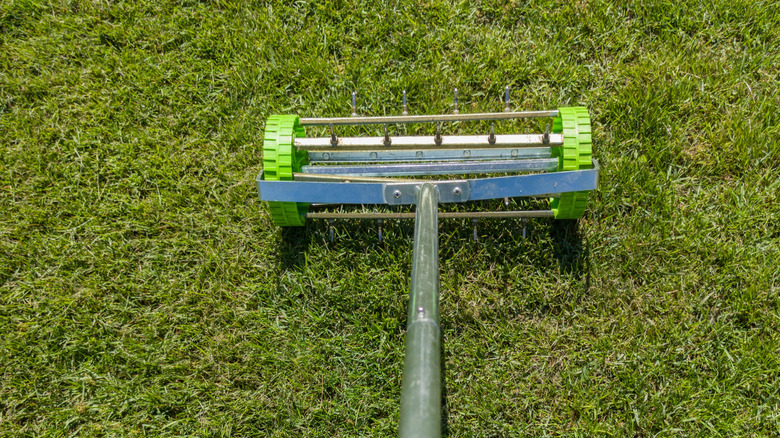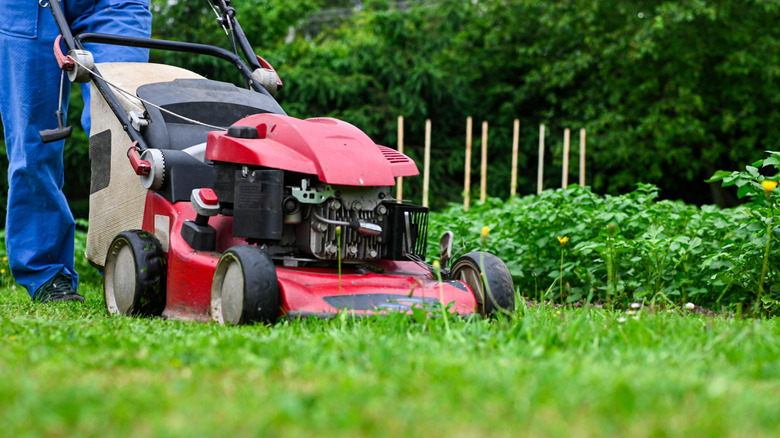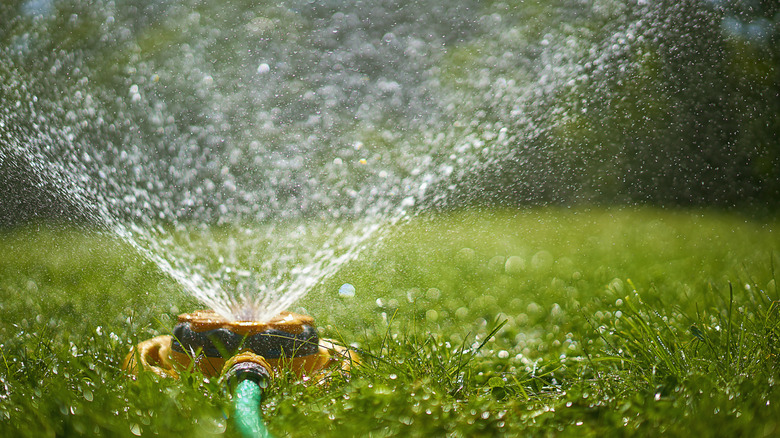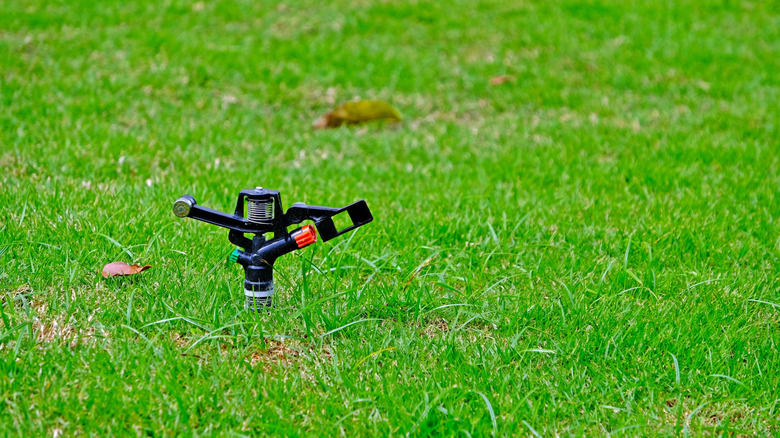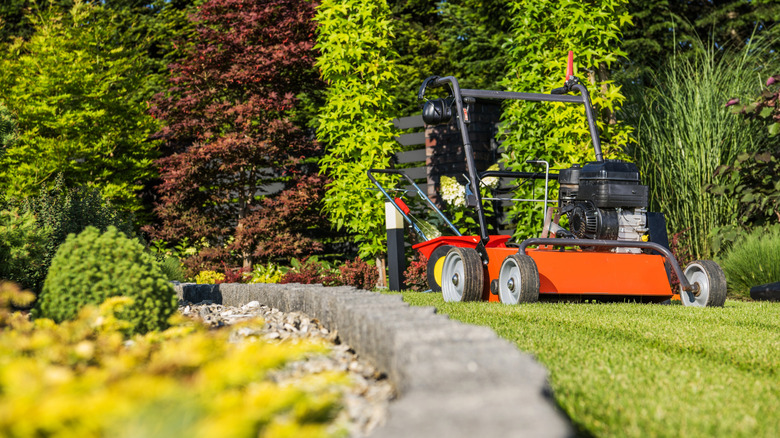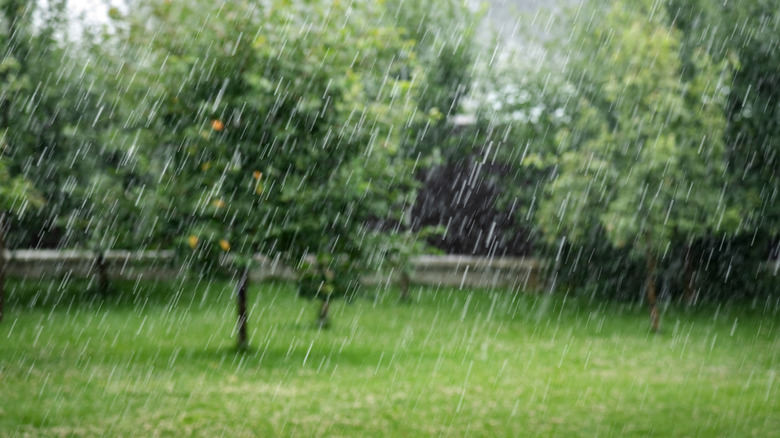Things You Should Always Do Before Aerating The Lawn For The Best Results
We may receive a commission on purchases made from links.
If your lawn is looking waterlogged or your grass and soil have become overly compacted from heavy foot traffic or other damage, it may be time to aerate it. If you're not familiar with aeration, it helps improve air circulation and reduces soil compaction to improve the health of the lawn by removing a plug of soil across the surface. Once aerated, water, oxygen, and other nutrients are better able to reach the roots to encourage lush and healthy growth. By aerating, you're also taking steps to improve drainage. So, if you have been having issues with water pooling on the surface, those should be greatly improved as well.
However, despite all the benefits that aeration has to offer, you shouldn't simply decide to pick up an aerator and start pulling out those plugs right away. There are several things you should do to make sure your yard is ready before you start thinking about how to aerate the lawn. If the grass is too long, the soil is too dry, or you haven't considered any obstacles on the lawn, you could be setting yourself up for serious problems. Your aeration attempts might not be successful, or you could inadvertently cause damage to fixtures in your lawn or the aeration machine itself.
Cut the grass short before aerating your lawn
One common mistake people make when aerating their lawn is doing so when the grass is too long. In fact, not only should you mow your lawn first, but you should also cut the grass a bit shorter than normal if you want your aeration attempts to be as successful as possible. The problem with aerating when the grass is too long is that it can interfere with the seed and fertilizer you spread after aeration from being able to penetrate as deeply into the soil. If you don't mow your lawn before you aerate, your grass can get too long and will require mowing shortly after you've finished. Mowing too soon after aeration isn't recommended because you want to give the new grass seed time to germinate and start growing.
The ideal height to mow your lawn can vary based on where you live and whether you have cool- or warm-season grass. It is generally recommended to mow warm-season grass to a height between 1 and 2 1/2 inches throughout the growing season and cool-season grass to a height between 2 and 3 1/2 inches (depending on the specific species). Before aerating, you'll want to cut the grass down to about an inch shorter than usual to deliver those penetration benefits shared above and to make sure you won't need to mow the lawn too soon after aerating it. Instead of shocking your lawn by cutting the grass so much lower than you typically do, plan ahead and start cutting it slightly shorter each mow as you get ready to aerate.
Water a few days before aerating to ensure that the soil is moist
Aerating a lawn with moist soil will be the most effective. If the soil is too dry, it may be too hard for the core aerator to effectively pull out soil plugs. This could result in wasted time and effort on your part. However, while bone dry soil isn't ideal for aerating, overly wet or puddling soil is not good either. Not only will it be difficult to push an aerator through the mud, but it also won't be able to pull out cores of soil. The aerator must be able to cut through the soil to pull out a solid/semi-solid plug of dirt. This will be impossible if the soil in your yard has the consistency of cake batter — would you be able to pull out a plug of batter without the rest of the mixture collapsing in and immediately filling in the hole you just made? Moreover, you'll likely end up clogging the aerator machine itself if you attempt to aerate a muddy lawn.
Instead, you need to reach the happy medium between dry and hard soil and a waterlogged or muddy lawn. To accomplish this goal, you should water the grass a day or two before you plan to aerate the lawn. This will ensure that it is soft and ready, while still giving enough time for the excess water to soak into the soil to prevent it from being too damp and muddy.
Remove or mark any obstacles in the yard to avoid causing damage
It is also important to take some time to make sure your yard is ready before you begin working. The grass should be clear of anything that could get in your way as you're working, such as lawn furniture, children's toys, sticks, or other debris. If you don't clear these items before aerating, you'll find that you are less efficient once you start the process. If you're constantly stopping and starting to move items out of your way as you encounter them, it will take a lot longer to finish the task. Moreover, you're risking damaging one of these items if you don't see it from behind the large aerator machine and inadvertently run it over.
While you can remove many of the obstacles that can get in your way, there may be others that cannot be moved, such as sprinkler heads, wiring, drainage pipes, or gas lines. While you can't physically remove these, you also don't want to run over them with the aerator. The machines are designed to penetrate up to 4 inches beneath the surface, which means they could cause serious (and potentially expensive) damage to such impediments. Since you can't move these obstacles, you should identify their location so you can aerate around them instead of going directly over them. Placing small flags, such as the Ace Supply marking flags, near your sprinkler heads or other obstacles is a simple way to make sure you don't run over them as you aerate.
Make sure you have the appropriate tools ready
There are two main categories of aerators — core aerators and spike aerators — each of which works in a different way. While spike aerators use tines to make small holes in the ground, core aerators remove plugs of soil from the lawn. If you have compacted soil and want to help improve airflow within the soil, then using a core aerator will likely be the best choice.
If you are only going to be aerating your own lawn the recommended one to two times per year (as opposed to running a lawn care business and aerating several lawns), then the cost to purchase a core aerator may not be worth it. If you have a very small property, you might consider buying a manual aerator, such as the Dolibest coring aerator. These types of aerators are designed to remove a few cores of soil at a time, and you'll need to reposition them every few inches throughout the yard to effectively aerate the soil. Alternatively, you can rent a gas- or electric-powered aerator if you have a larger property. Just make sure you rent the right kind of aerator for your yard by requesting a core aerator.
In addition to the aerator, there are some other tools and materials that you'll want to have on hand. First, you'll need your mower and hose/sprinkler so you can cut the grass and water the lawn ahead of aerating it. If you're going to overseed after aeration (which is highly recommended), you'll also want grass seed and a broadcast spreader, like the Scotts Turf Builder EdgeGuard DLX broadcast spreader.
Double check the calendar and weather forecast
Getting your timing right when aerating the lawn is important. Many people don't realize that there is a best time of the year to aerate the lawn. This will vary based on where you live and the type of grass you have. If you have cool-season grass, you should aim to aerate your lawn towards the end of the summer or in the early fall. During this time of the year, the daytime temperatures are still warm enough to help the new grass seed grow, but they're not so hot that they'll add unnecessary stress to the lawn. If you live in a hotter climate with warm-season grass, late spring or early summer are generally seen as the ideal time for aeration. Warm-season grasses grow best during these parts of the year, so improving the soil to help the new seeds you plant will deliver the best results.
You should also pay attention to the weather forecast before aerating. While some rain in the days leading up to your planned aeration isn't a bad thing, you won't want to aerate after several days of heavy storms. If you remember from above, moist soil allows the corer to remove the soil plugs more easily, but you won't be able to remove clean plugs from muddy soil and it may clog the aerator. You also should not plan to aerate if your area is going through a drought. While you may be able to moisten the soil before aerating using a sprinkler, it will dry back up quickly. This can prevent the new grass seed from establishing strong and healthy roots.
